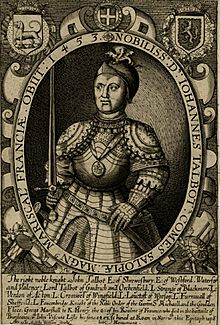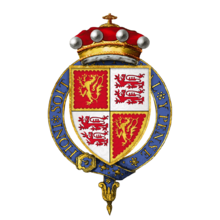John Talbot, 1st Earl of Shrewsbury facts for kids
Quick facts for kids
John Talbot
|
|
|---|---|

A picture from the Talbot Shrewsbury Book showing John Talbot, 1st Earl of Shrewsbury, presenting the book to Margaret of Anjou, Queen of England, 1445. He is identified by a talbot dog.
|
|
| Born | c. 1387 Blackmere castle, Shropshire 52°58′40″N 2°39′24″W / 52.97767°N 2.65680°W |
| Died | 17 July 1453 (aged 65–66) Castillon-la-Bataille, Gascony |
| Cause of death | Slain in battle |
| Resting place | St Alkmund's Church, Whitchurch |
| Title | 1st Earl of Shrewsbury |
| Tenure | 20 May 1442 – 17 July 1453 |
| Other titles |
1st Earl of Waterford
7th Baron Talbot 10th Baron Strange 6th Baron Furnivall |
| Known for | Military activity during the Hundred Years' War |
| Offices | Lieutenant of Ireland Lord High Steward of Ireland Constable of France |
| Spouse(s) |
|
| Issue | |
| Occupation | Soldier |
| Military career | |
| Allegiance | |
| Service/ |
English army |
| Years of service | 1404–1453 |
| Conflicts |
|
| Awards | Order of the Garter (1424) |
| Memorials | Near Castillon-la-Bataille |
John Talbot, 1st Earl of Shrewsbury, born around 1387 and died on July 17, 1453, was an important English nobleman and military leader. He was famous during the Hundred Years' War between England and France. People called him "Old Talbot" or the "English Achilles" because he was so brave and feared by the French. Even William Shakespeare wrote about him in his plays.
Talbot was known for being a tough and daring soldier. He died leading a charge against French cannons, which many see as a symbol of the end of the age of knights and chivalry.
Contents
Who Was John Talbot?
His Family Background
John Talbot came from a very old family. His ancestors were related to William the Conqueror, a famous English king. His family held lands in England for many centuries.
John was born around 1387 at Black Mere Castle in Shropshire. His father was Richard Talbot, 4th Baron Talbot. His mother was Ankaret, who was the only heir of the 4th Baron Strange of Blackmere.
John had an older brother named Gilbert, who was supposed to inherit their parents' titles. He also had a younger brother, Richard, who became a very important religious leader in Ireland as the Archbishop of Dublin. Richard was a strong supporter of John throughout his life.
His Early Life and First Marriage
John's father died when he was about nine years old. His mother, Ankaret, then married Thomas Neville, 5th Baron Furnivall. This marriage was important for John because Thomas Neville had no sons. This meant that his title, Baron Furnivall, would pass to his eldest daughter, Maud.
Maud Neville was John's stepsister, and she later became his first wife. They married before March 12, 1407. Because of this marriage, John was also known as John Talbot, 6th Baron Furnivall.
John and Maud had several children together:
- John Talbot, 2nd Earl of Shrewsbury (born around 1413)
- Thomas Talbot (born and died in 1416)
- Lady Katherine Talbot (born around 1418)
- Sir Christopher Talbot (born 1419)
- Lady Joan Talbot (born around 1422)
- Lady Ann Talbot
Maud died on May 31, 1422. Later, in 1421, John inherited the titles of Baron Talbot and Baron Strange of Blackmere from his niece, who had died.
His Second Marriage
On September 6, 1425, John married Lady Margaret Beauchamp at Warwick Castle. She was the eldest daughter of a powerful nobleman, Richard de Beauchamp, 13th Earl of Warwick.
John and Margaret had five children:
- John Talbot, 1st Baron Lisle and 1st Viscount Lisle, who died with his father in battle.
- Sir Louis Talbot (born around 1429)
- Sir Humphrey Talbot (born before 1434)
- Lady Eleanor Talbot (born around 1436), who later became a mistress to King Edward IV.
- Lady Elizabeth Talbot (born around 1442)
John Talbot's Military Career
Fighting in Wales and Ireland
From 1404 to 1413, John Talbot fought alongside his older brother Gilbert in the Welsh revolt, also known as the Glyndŵr Rising. This was a rebellion led by Owain Glyndŵr against English rule in Wales.
After this, from 1414 to 1419, he served as the Lord Lieutenant of Ireland. This was a very important job, like being the king's representative. He had to fight in Ireland and also deal with arguments over land. He was known for being a strict ruler.
John had a big disagreement with the Butler family in Ireland. This argument became very serious and involved many important people. Both sides were told off by the king's council for making English rule in Ireland weaker. Eventually, peace was made when John's son married a daughter from the Butler family.
Battles in France
John Talbot became truly famous for his actions in France during the Hundred Years' War.
- First time in France: From 1420 to 1424, he served in France. He fought in the Battle of Verneuil in 1424, where he showed great bravery. For his service, he was given the Order of the Garter, a very special award.
- Capture and Release: In 1427, he went back to France and fought bravely in battles like the Siege of Orléans. However, he was captured at the Battle of Patay on June 18, 1429. He was held prisoner for four years before being released in 1433 in exchange for a French leader.
- A Daring Soldier: Talbot was known for being a very daring and aggressive soldier. He was always ready to attack and retake towns from the French. His quick and bold attacks were his trademark. He was made governor and lieutenant general in France and Normandy.
- "King Talbot": After the Duke of Bedford died in 1435, John Talbot became the main English general in France. The French even called him le roi talbot, meaning "king Talbot," because he was such a powerful and feared leader.
- More Victories: He won many important battles and retook several towns. In 1436, he defeated French forces near Rouen. In 1437, he surprised the town of Pontoise near Paris, threatening the capital. He also retook Harfleur in 1440.
Becoming Earl of Shrewsbury
In February 1442, Talbot returned to England to ask for more soldiers for the war in France. On May 20, King Henry VI made him the Earl of Shrewsbury. This was a very high honor. Just five days later, he returned to France with the new soldiers.
In 1445, King Henry VI, who also claimed to be the king of France, made Talbot the Constable of France. This was another very important military position.
The End of His Career
His Last Battle
In 1449, Talbot was captured again at Rouen. He promised he would never wear armor against the French King again. He kept his word, but he still led English forces against the French, just without fighting himself.
In 1452, he was sent to Bordeaux in France to help defend English lands there. He arrived on October 17. With some new soldiers, he captured the town of Fronsac.
However, John Talbot was finally defeated and killed on July 17, 1453, at the Battle of Castillon near Bordeaux. This battle was a huge loss for England and effectively ended English rule in that part of France. It also marked the end of the Hundred Years' War.
Reports say that his horse was hit by a cannonball and fell on him, trapping him. A French soldier then killed him with a battleaxe. His heart was buried at St Alkmund's Church, Whitchurch, in England.
His Legacy
Even though he was defeated at the end, John Talbot was remembered as a great soldier. A French writer at the time, Matthew d'Escourcy, wrote that Talbot had been "one of the most formidable thorns in the side of the French, who regarded him with terror and dismay."
Some people have said that Talbot was too reckless in battle, especially at Castillon. He attacked the French camp head-on, even though they had many cannons, and he didn't wait for all his soldiers to arrive. However, his daring and aggressive style had often brought him success before.
Cultural Influence
John Talbot is shown as a hero in Shakespeare's play Henry VI, Part 1. In the play, he is called "Valiant Lord Talbot, Earl of Shrewsbury, Created, for his rare success in arms." Shakespeare's play made Talbot famous again, even two centuries after his death.
In Video Games
- John Talbot appears as a character in the video game Bladestorm: The Hundred Years' War.
- He is also one of the main bad guys in the PSP game Jeanne d'Arc.
Images for kids
-
The Death of Shrewsbury at the Battle of Castillon, as painted by Charles-Philippe Larivière.
-
A statue of John Talbot, 1st Earl of Shrewsbury, at Whitchurch, Shropshire. A talbot dog is shown as his footrest.





